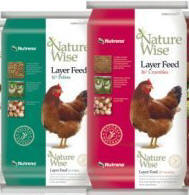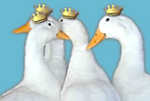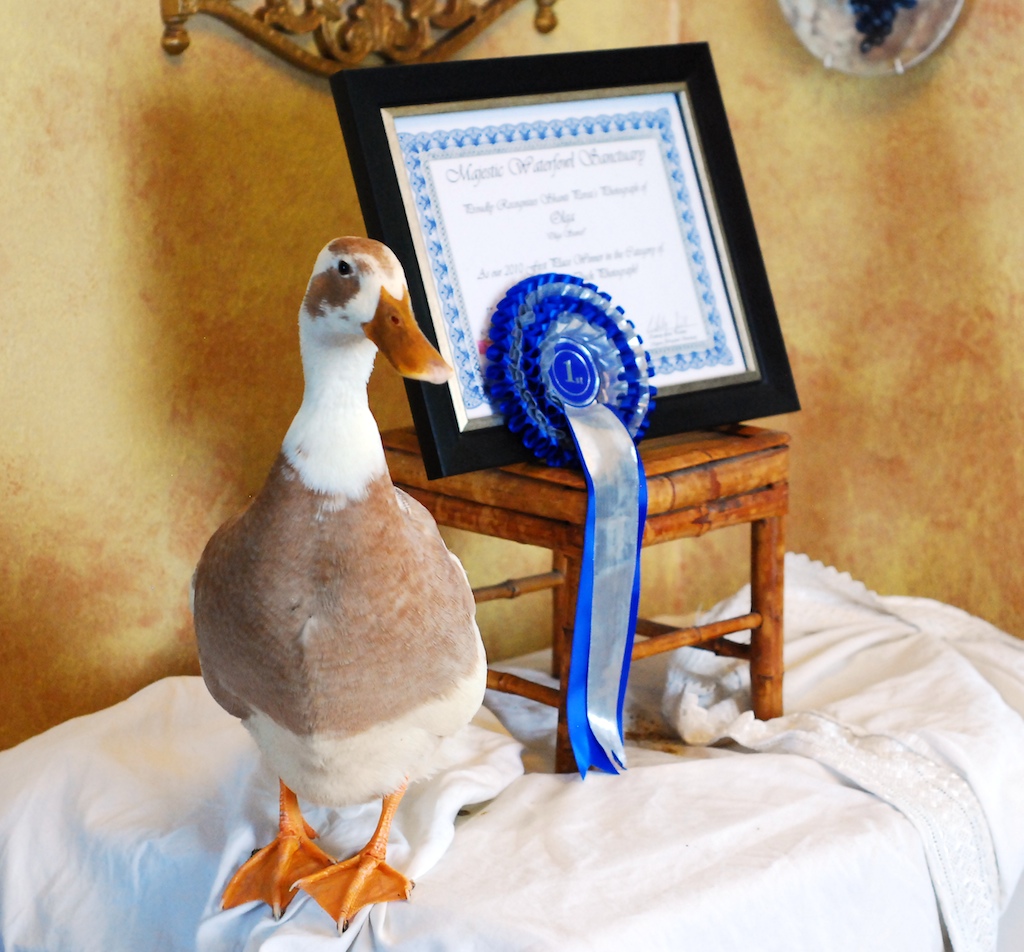We tried a new feed product last month and wanted to share our results. Rescued Muscovy duck Bella has been laying soft eggs since her arrival at our sanctuary. We switched out her Mazuri food with a 100% ration of Nutrena® NatureWise® Layer Feed with amazing results. Within one week of her dietary change she began consistently laying hard-shelled eggs.
While the remainder of our ducks and geese continue to thrive on the Mazuri diet, Bella is doing fantastically well on her new specialized diet.
For those of you with ducks or geese who consistently lay soft-shelled eggs, we recommend you give this Nutrena® product a try in place of their regular layer/breeder formula. While we can't guarantee it will work for everyone, we're hoping it will help some of our feathered friends. Please email us and let us know if this product helps alleviate your duck or goose's soft egg issues!
Bella admires three of her hard-shelled eggs
Remember, Nutrena® NatureWise® Layer Feed is recommended for mature laying hens. It comes in both pellet form or crumbles, which is very convenient for those ducks or geese who have broken bills and who often fare better on a smaller consistency food. Be sure to use all contents within 60-90 days of the date stamped on the bag (within 60 days being preferable).
As always, a separate feed dish containing calcium chips or oyster shells should also be made available to your egg-laying duck or goose 24/7.
For more information on this and other Nutrena® products check out our May Newsletter and visit Nutrena's website: www.nutrenaworld.com.
Nutrena® NatureWise® Layer Feed
Expertly designed and formulated for natural, balanced nutrition to support production of fresh, hard-shelled eggs.
- A complete, nutritious vegetarian diet—no need for supplementation
- 16% protein and fortified with vitamins and minerals to promote hen health and egg production
- Contains a proprietary blend of nutrients to naturally support the immune system and overall health of the bird
- NO added antibiotics or hormones
- Added marigold extract for golden yolks
- Added prebiotics, probiotics and yeast culture that support digestion
- Available regionally in a pellet or a crumble form. Check with your local Nutrena® retailer for availability in your area.
 Layer Pellets
(green bag)
/ Layer Crumbles (red bag)
Layer Pellets
(green bag)
/ Layer Crumbles (red bag)
Zinc Toxicity Revisited
Poultry Normal Range: 1.0 - 3.4 ppm (parts per measure) as confirmed by blood test. Test results usually take 7-10 days.
Crystalloid Solution
In cases where zinc toxicity is low and the source has been removed, vets may attempt to increase your duck or goose’s urine flow with a crystalloid solution to flush the zinc out.
EDTA
If your duck or goose's zinc levels are high enough to warrant intervention, a chelating agent is commonly prescribed. Injections of C-VT Calcium EDTA solution is the most common and effective treatment.
C-VT Calcium EDTA is a heavy metal chelating agent. It is injected into your duck/goose or given as an IV treatment. It goes into your bird’s body and binds with heavy metals. The agent then leaves the body through the urinary tract, taking some of the heavy metals along with it.
Side effects include diarrhea and vomiting. Since it also removes other minerals from the body, excess loss of calcium (hypocalcemia) can result. Calcium levels should be closely monitored—especially in laying hens, who rely heavily on calcium to produce their eggs. Calcium sources (such as oyster shells or calcium chips) should be removed during treatment and for a couple hours afterwards, and then reintroduced again.
Vets will commonly inject EDTA intramuscularly twice daily for five days. After this, they stop the treatment for four days. On the fifth day, they begin the treatment again for another five days. After two weeks they retest your duck or goose’s zinc levels by drawing more blood.
D-Penicillamine
A less effective treatment is D-Penicillamine (or Cuprimine). It is dosed orally and also helps draw zinc out of the body. The trouble with this drug is it can be near impossible to get your hands on. You have to go to a human pharmacy to get it and most pharmacies don’t stock it and will not special order it due to the low demand and high cost.
DMSA
If neither of these treatments are readily available where you are, your vet may instruct you to purchase over-the-counter DMSA (dimercaptosuccinic acid), which can also be found online. DMSA is also a good option to get your pet started on a chelating program while you wait for a special order of C-VT Calcium EDTA to come in.
Our vet prescribed a dose of 25-35 mgs DMSA daily for every 2.2 pounds of bird weight.
-
This means a 15 pound goose with high zinc levels would do best on a dose of 240 mgs daily, while a goose with lower zinc levels might do better on a dose of 170 mgs daily.
-
Similarly, a 7 pound duck with high zinc levels would do best on a dose of 110 mgs daily, while a duck with lower zinc levels might do well on 80 mgs daily.
DMSA is often given to your bird on an empty stomach for maximum absorption. Side effects may include nausea, so it is advisable to divide capsules and space them out over the course of the day. Instead of giving one dose per day, most vets will advise you to split the dosage into two, three or four doses (with three or four being most preferable). You can either dose morning, noon and night OR you can dose every eight hours over a twenty-four hour period.
If nausea and loss of appetite become an issue you may need to reduce the overall dosage a bit. Discuss this possible outcome with your vet before beginning a treatment regimen, so you are prepared for any scenario.
Although you may be tempted to pull capsules apart and sprinkle them over your pet’s food, understand that it has a very bad taste (and odor), which may discourage your pet from eating. For this reason, it is advisable to purchase some empty gelatin capsules, which will enable you to divvy up their daily dosage into 3-4 equal parts and spare them any "fowl" flavor.
DMSA is often administered with rest periods in mind. Birds are often dosed for 3-5 days depending on their zinc level, their recommended dosage and their individual tolerance. Most vets will go with a three-day dosage period; however, if your duck or goose is having exceptional difficulty tolerating DMSA (which is rare), they can be dosed every other day for five days.
Following this 3-5 day treatment period comes a 3-11 day rest period (with 11 days being ideal). Not only will this give your duck or goose time to recover from any nausea experienced, but it will allow their body time to recover from the loss of glutathione (which is their body’s natural chelator that helps push heavy metals outside of their cells). Once glutathione is naturally restored to their body, the next dosing period of DMSA begins.
Basically, you want to ensure your pet’s dosing cycle provides them with enough medicine to counteract their high zinc levels without risking their overall well-being.
Their health in mind, an experienced vet will advise you to give your pet a special mix of vitamins during the rest periods between DMSA dosing. These supplements will restore those healthy minerals that are incidentally bound and removed from their body along with the zinc. They include: iron, calcium and magnesium.
REMEMBER: All of the above-listed treatment options draw calcium from the body, so calcium levels in laying hens should be monitored closely.
Calcium sources should be removed at dosing times and then re-introduced a couple of hours afterwards, or in the case of DMSA treatment, their calcium should be removed during their 3-5 day dosing cycle and then reintroduced during their 3-11 day rest period.





 Our 2010 Most Comical Winner "Olga" poses with her Award!
Our 2010 Most Comical Winner "Olga" poses with her Award!